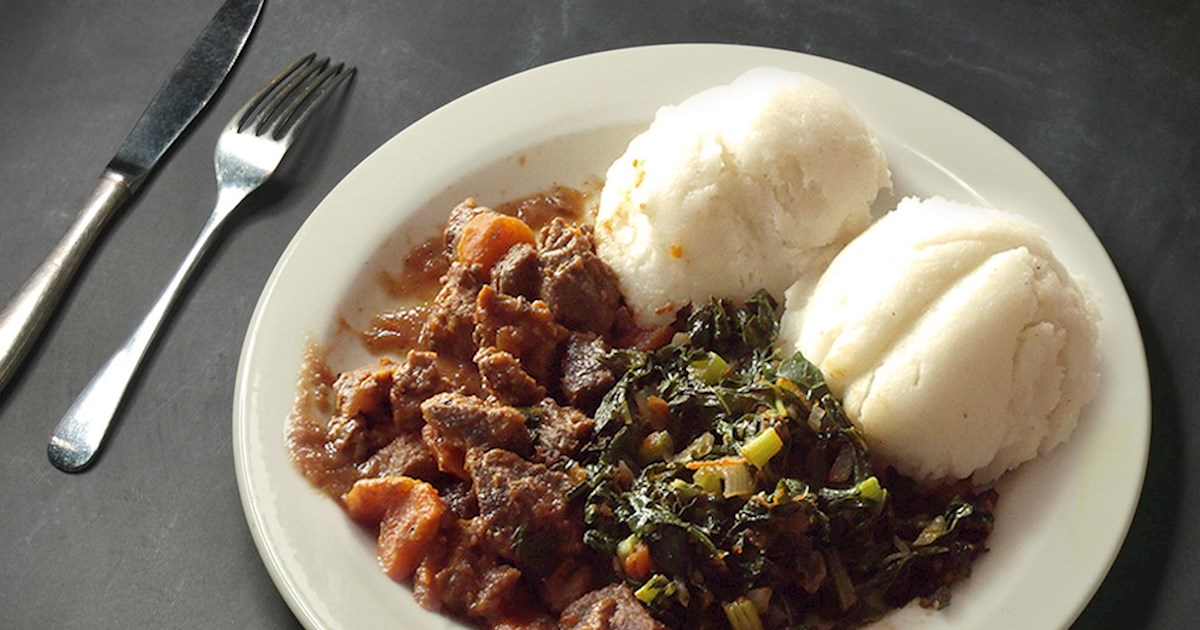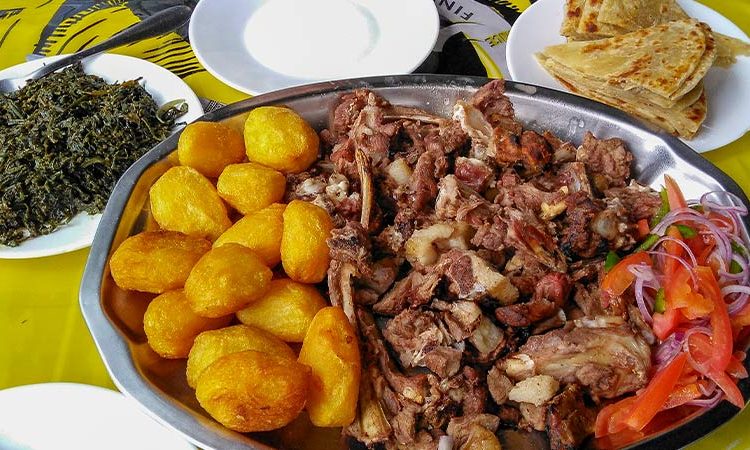- GET IN TOUCH WITH US:
- +256 753518160
- +256 777842166
- info@experiyatourcompany.com

Can I visit Maasai villages?
November 18, 2025What Traditional Foods Should I Try in Kenya?
Kenya’s culinary landscape is as diverse as its sweeping savannahs, turquoise coastlines, snow-capped mountains, and vibrant cultural mosaic. Food in Kenya is not just nourishment; it is storytelling, history, community, and identity served on a plate. Every dish carries a tale—of migration, trade, pastoral traditions, coastal influences, and ancient agricultural practices that have shaped the country for centuries. Whether you are wandering the streets of Nairobi, visiting a Maasai village, dining in a seaside restaurant in Mombasa, or sharing a family meal in the highlands, you’ll discover that Kenyan cuisine is a flavorful reflection of its people’s everyday life and cultural pride.
If you’re planning a trip to Kenya, one of the most rewarding experiences you can have is diving into its rich traditional food scene. This detailed guide explores the must-try Kenyan dishes that define the nation’s culinary identity, the cultural stories behind them, and the unique flavors that await you during your travels.
Ugali
No traditional Kenyan meal is complete without ugali, considered the backbone of the country’s cuisine. Ugali is a dense, smooth porridge made from maize flour cooked to a firm, dough-like consistency. It is simple, hearty, and incredibly filling. Because maize is one of Kenya’s staple crops, ugali is a daily household dish for millions of families.
It is traditionally eaten with the hands, using small pieces to scoop up vegetables, stews, or grilled meats. The beauty of ugali lies in its versatility—it pairs with almost every Kenyan dish. Whether you’re in a coastal village or a bustling Nairobi eatery, you can expect ugali to appear as a comforting and familiar companion on your plate.
Nyama Choma
Ask any Kenyan what food defines their country, and the answer will often be nyama choma. Literally meaning “grilled meat,” nyama choma is a beloved social dish typically prepared from goat or beef, though chicken and fish versions also exist. It is slow-roasted over open flames, seasoned simply with salt or light spices, allowing the natural meat flavors to shine through.
Nyama choma is typically enjoyed in groups—families gather, friends meet after work, and travelers are welcomed to join in. The experience is as much about the atmosphere as the meal itself. The smoky scent from the grill, the sound of crackling meat, and the lively conversations make nyama choma a ritual of connection. It is often served with kachumbari (fresh tomato-onion salad) and ugali, making it a complete, unforgettable Kenyan food experience.
Sukuma Wiki
Meaning “stretch the week,” sukuma wiki is a dish deeply rooted in Kenyan home cooking. It is made from collard greens sautéed with onions, tomatoes, and sometimes a hint of spices. The dish earned its name because it is affordable, nutritious, and can sustain a family even when budgets are tight.
Sukuma wiki is typically served alongside ugali and meat dishes, adding vibrant color and vital nutrients to the Kenyan plate. For many Kenyans, sukuma wiki represents comfort, resilience, and the simplicity of everyday living.
Githeri
Originating from the Kikuyu community but now enjoyed throughout Kenya, githeri is a wholesome, one-pot dish of boiled maize and beans. It can be prepared plainly or enriched with potatoes, vegetables, or beef. The dish embodies Kenyan simplicity yet delivers deep satisfaction.
Historically, githeri was a staple in rural households and school meals, but it has evolved into a celebrated dish that appears in restaurants across the country. Its earthy flavors and nutritious profile make it a beloved traditional meal ideal for travelers seeking a taste of local life.
Pilau and Biryani
Kenya’s coastline has a rich culinary influence shaped by centuries of trade with Arabs, Persians, Indians, and later, Portuguese merchants. Nowhere is this more evident than in the Swahili dishes pilau and biryani. These rice-based meals are infused with aromatic spices such as cardamom, cumin, cloves, cinnamon, and black pepper.
Pilau is a savory rice dish where spices are cooked directly with the rice and meat, creating a warm, rich, flavorful meal. Biryani, on the other hand, is a layered rice dish where meat or chicken is cooked separately from the rice, then combined to create contrasting textures and tastes. Both dishes are often served with fresh kachumbari or spiced coconut sauces.
When you travel through coastal towns like Mombasa, Lamu, or Malindi, you will find pilau and biryani at the heart of Swahili celebrations, weddings, and daily meals. They reflect the multicultural history and deep hospitality of Kenya’s coast.
Chapati
Chapati is one of Kenya’s most beloved flatbreads, influenced by Indian cuisine but deeply adapted into East African culture. Made from wheat flour, water, and oil, chapatis are rolled thin and pan-fried until soft, golden, and slightly crispy at the edges.
Kenyan chapatis are softer and richer than their Indian counterparts, often served with beans, stews, lentils, or tea. They appear on special occasions, Sunday family meals, and even roadside cafés where the smell of fresh chapatis pulls in hungry travelers. Eating chapati in Kenya is a delicious, comforting experience that reflects the country’s history of cultural exchange.
Mukimo
Mukimo is a mashed mixture of potatoes, green peas, maize, and pumpkin leaves or spinach. It has a smooth, hearty texture and is traditionally prepared for family gatherings, celebrations, and community feasts. Its vibrant green color comes from the leafy vegetables used in the mixture.
Often served with beef stew or nyama choma, mukimo is a wholesome reminder of the agricultural heritage of Kenya’s central highlands. Each bite is a warm connection to traditional farming life and communal dining.
Matoke
Though strongly associated with Uganda, matoke is also widely prepared in western Kenya, especially among communities near Lake Victoria. Matoke consists of green cooking bananas peeled, boiled, and stewed with onions, tomatoes, and sometimes beef or groundnut sauce.
Its soft, tender texture and sweet-savory flavor make it a comforting dish that appeals to both locals and travelers. Matoke embodies the shared culinary traditions across East Africa and the agricultural richness of the region.
Fish from Lake Victoria
Travelers visiting Kisumu or the villages bordering Lake Victoria must try the region’s iconic fresh tilapia. Served fried, grilled, or stewed in coconut sauce, Lake Victoria fish dishes are flavorful, succulent, and deeply tied to the identity of western Kenyan cuisine.
You’ll often find fish served with ugali and fresh vegetables, creating a balanced and satisfying traditional meal. Eating tilapia by the lakeside, with fishermen mending nets nearby, immerses you in the authentic spirit of Kenya’s waterside culture.
Irio: A Traditional Kikuyu Dish
Irio is another traditional staple from the Kikuyu community. Similar to mukimo but simpler, it combines mashed potatoes, green peas, and maize without the pumpkin leaves. Irio is nourishing and typically served with grilled meat or vegetable stews. It is a gentle, comforting dish that reflects the rural lifestyle and nutritious eating habits of central Kenya’s farming communities.
Mandazi and Mahamri
Kenya’s coastal region is famous for its sweet, aromatic pastries: mandazi and mahamri. These fluffy, deep-fried dough pieces are lightly sweetened and infused with coconut milk, cardamom, or nutmeg.
Mandazi is simpler and less sweet, while mahamri is richer with a pronounced coconut and spice flavor. Both are typically enjoyed with chai or as a snack during coastal gatherings. Their soft texture and sweet fragrance make them irresistible for travelers exploring Mombasa’s vibrant streets or Lamu’s narrow alleyways.
Kenyan Tea and Coffee
Beyond solid foods, Kenya is world-renowned for its exceptional tea and coffee. Kenyan tea is bright, strong, and aromatic, often served with milk and sugar as chai. Kenyan coffee ranks among the best globally—bold, rich, and fruity, grown in the high-altitude volcanic soils of the central highlands.
Sipping a cup of freshly brewed Kenyan tea or coffee connects you to the country’s agricultural heritage and its globally celebrated beverage culture.
Why Food Matters in Your Kenyan Journey
Traditional Kenyan dishes offer more than flavor—they provide insight into the soul of the country. Each meal is a doorway into Kenya’s cultural diversity, from pastoral Maasai traditions to Swahili coastal cuisine, highland agriculture, and lakeside fishing communities. When you eat local, you form deeper connections with the people, stories, and traditions that define Kenya. Sharing meals with locals, enjoying street food, or dining in traditional eateries allows you to become part of the communal spirit that makes Kenyan culture warm, welcoming, and unforgettable.
Experience Kenyan Cuisine with the Right Travel Partner
Exploring Kenya’s traditional foods is one of the highlights of traveling through this beautiful country. From hearty staples like ugali and githeri to aromatic coastal biryani, smoky nyama choma, and sweet mandazi, every dish enriches your journey with flavor and cultural depth. To ensure that your culinary experiences and overall trip are well-planned, authentic, and unforgettable, consider booking your travels with Experiya Tour Company. Their deep local knowledge, curated itineraries, and commitment to cultural immersion ensure you experience Kenya not just as a visitor, but as part of its vibrant culinary story.




